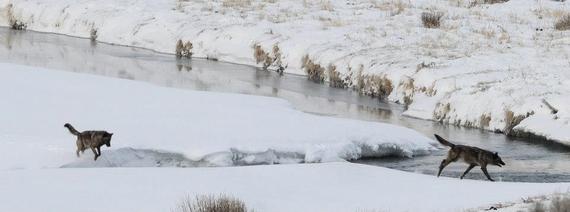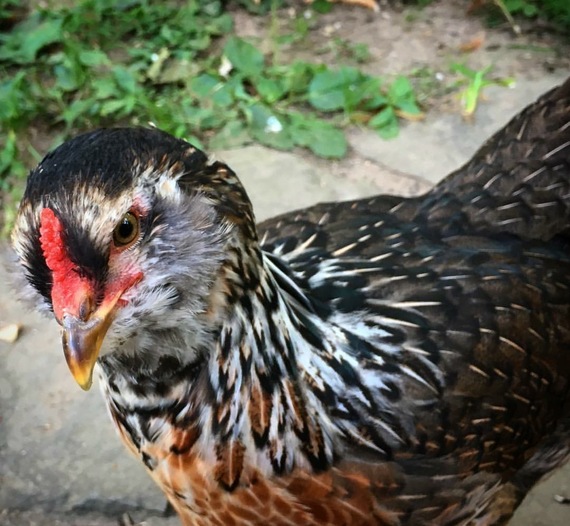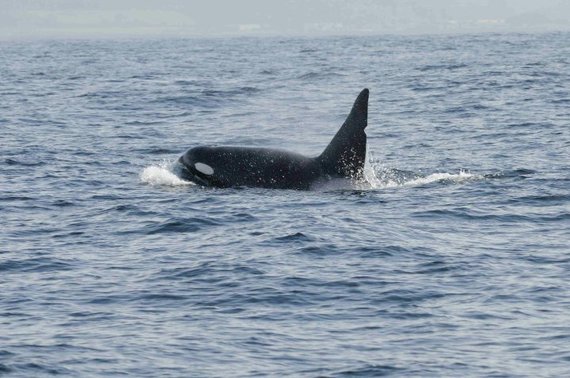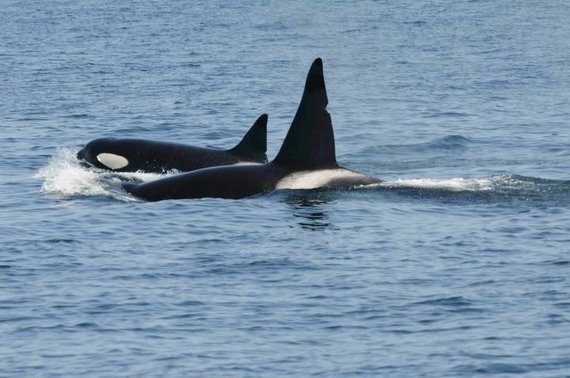This is Part II of a two-part story titled "Personality; Not Just for People Anymore."
Every wolf, every animal, is different. Credit: Carl Safina
It's easier to accept that elephants, dolphins, wolves, and dogs have personalities. What's surprising -- until you make individual acquaintances -- is how deep and widespread the phenomenon of personality is. When you work with hawks, say, you see that each responds a little differently, each hunts a bit differently.
I define personality as individually differing responses to the same stimuli. My friends the professors Peter and Judy Weis of Rutgers University watched researchers at a lab in Italy present a crab in a jar to each of two octopuses. The first octopus popped off the top and devoured part of its prize. "Then it replaced the cap on the jar as if to save the rest for later," say my friends. The second octopus had been hungrily slithering back and forth across the glass tank, so the scientists expected an instant pounce. But when the jar splashed in, Octopus Two, apparently frightened, darted behind a rock. "It didn't care what was in the jar." Peter said. Judy elaborated: "We really don't appreciate how much personality most animals have. Even as scientists, we've hardly ever thought about that."
I'm not going to tell you what creatures Darrel Frost is talking about. Try to guess. I'm in his office at the American Museum of Natural History in New York City and he's introducing me to his pets, saying, "Mud is the larger one with the undershot jaw. Hermes, with the broken back, has epilepsy. Before our secretary, Iris, retired a year ago, they would run down to her office to get goodies from her. She visited yesterday, and even though they hadn't seen her in months, they still get really excited when she comes into the room. When Mud is really excited, he will almost dance side to side. Likewise when our volunteer, Denny, visits to pamper them -- they just light up. I'm the one who feeds them, but I never get that kind of reaction. Iris and Denny lecture me that I don't talk to them enough.
"Mud is like a little kid, incredibly curious when people are in my office. He wants to come in to see if people are having fun without him. He will scrape at the door until he is let in. Hermes has always been more shy around strangers. Mud loves Mexican music; it gets him running around.
When Mud would start getting out of hand, Iris would just touch his nose with the eraser end of a pencil and he would get very upset, stop what he was doing, and sulk. A soft touch, but he knows who is in charge. He could easily have pushed her out of the room, but her disapproval was clearly hard on him.
"The funniest thing is that they know their names but if you catch them doing something they shouldn't do and you call their name, they will look away to avoid eye contact. One day Mud extremely quietly came in, and very quietly opened the door of the small refrigerator and was quietly working on a head of lettuce. After I noticed, I watched him for a moment. It was the quietest I had ever seen him. He knew that if he got busted he would have his lettuce taken away, so he was trying to keep from attracting my attention. And, jeez, when I closed the fridge door, was he mad! He had a little tantrum right there, jerking back and forth -- and then he ran back into Iris's office so he could be with her.
"Over and over again, both Mud and Hermes present jealousy, sneakiness, venality, excitement, wanting to belong -- behaviors that I associate with two- to three-year-old humans. They have dominance hierarchies and, like big dogs, they develop strong attachments to their 'masters.'"
I ask what they weigh. Regarding them with a look both affectionate and appraising, Darrel says, "Mud is right at one hundred pounds, and Hermes, because of his health problems I think, is at eighty-five pounds. They're still young." The species' maximum size is around two hundred and fifty pounds, making spur-thighed the largest mainland-dwelling tortoise.
People used to think turtles were deaf. I am beginning to realize how blind we've been.
Researchers have now found individual personality differences in monkeys, rats, mice, lemurs, songbirds, sunfish, stickleback fish, killifish, bighorn sheep, domestic goats, blue crabs, rainbow trout, jumping spiders, house crickets. In other words, pretty much everywhere they've looked, they've found that individuals differ in behavior. Some are more aggressive, bolder, shier, some more active; some fear the new, while others are explorers. Among our chickens, Zorro is the explorer. She's often alone, out standing in her field, away from cover and companions. Sometimes her independence make me worry like a mother hen.
Zorro the chicken. Credit: Erica Cirino
Dolphins have personality galore. And Killer whales, or orcas, are the largest dolphins; they have the biggest brains. Canadian researcher John Ford started out working in aquarium shows where killer whales impressed him as "incredibly perceptive," each responding differently to different people. Because they "make a game of changing things," he found them quite challenging. In subtle ways that he did not sense at first, he eventually realized that his own behavior "was being modified by them." Another thing he discovered: each whale's personality is "strikingly different."
The free-living killer whale known to researchers as L-87 is known for outsized personality. After his mother died a decade ago, L-87 became the only killer whale known to have switched pods. (Three pods -- designated J, K, and L -- make up the resident killer whales of the waters of Washington State.) He went with K pod for a few years and now usually swims with the Js.
Researcher Ken Balcomb says, "He's always spy-hopping to look around at the boats. Sometimes suddenly -- phoosh!- - here he is with his head up right alongside, obviously playing. He likes the reaction of the people. He has a sense of humor. They're not all like that."
A wild killer whale. Credit: Carl Safina
Two killer whales captured in British Columbia in 1968 and 1969 were shipped to a place called Marineland of the Pacific, near Los Angeles and named Orky and Corky. A young Alexandra Morton (who later became a noted conservationist) watched amazed as they invented complex swimming routines and a morning "ritual." In the hour or so before the sun finally burst over the stadium rim, they "diligently squirted water at a particular spot on the tank wall, right at the waterline." When the first shaft of sun struck the wall, it touched the waterline "at the exact spot" the whales had marked. "No one, I thought, is going to believe me." As the spot moved in response to the earth's rotation month to month, "the whales always knew just where the first shaft of light would hit the water." A killer whale Stonehenge? Early killer whale astronomers?
Sun observation was a morning activity, but "Orky was less of a morning whale" and often tried to resume resting. When this happened, Corky sometimes ran the tip of her pectoral fin from the tip of his jaw, down his belly, and over his genital slit. "If this didn't cause an immediate bulge in the smooth pocket that housed his penis, Corky escalated her tactics...what Corky wanted was sex, and whale sex is a turbulent affair." With Corky's genital area "flushed with rosy excitement," water splashed out of the tank as the whales entwined and spiraled. When Corky was pregnant, Orky would go through all the foreplay but not copulate. That, Morton says, "drove Corky wild."
But how did the Orky know? Had he been scanning her body with his sonar, his own ultrasound?
Corky's first baby died. In 1978, Corky gave birth again. The problem was that the small tank required tight circling, and with Corky trying to guide the baby away from hitting the wall, the baby was seldom following in the position that properly presented her mother's teats for nursing. When this baby too grew thin, Management decided to try force-feeding the baby in a shallower pool. Handlers put the baby in a sling; a crane pulled the sling into the air.
Alexandra Morton was there: "As her baby's voice left the water and entered the air, the mother threw her enormous body against the tank walls, again and again, causing the entire stadium to shake. I burst into tears. Corky slammed her body for about an hour."
Morton wrote that the night Corky's baby was taken, she kept repeating a new and different sound, "guttural, and urgent." After each breath, Corky returned to the bottom of the tank, resuming her lament. The baby's father, Orky, occasionally uttered gunshot-like echolocation sounds that might have located a lost baby miles away at sea but were useless in a concrete tank.
Over three days Corky's calls grew hoarse. At dawn on the fourth day, Corky grew silent, rose, took a breath, and called, Pituuuuuuuu. Her mate returned the same call, and the whales began moving and breathing in unison. Corky ate for the first time since her baby was removed. Grief, mourning, recovering -- but not forgetting. After that, Corky began lying by a window with a view of gift-shop merchandise. For hours she'd stay there -- viewing a stack of toy stuffed orcas. Did the toys remind her of her lost children? Did she think that somewhere in there were her babies?
Corky got pregnant again. Then one day, she -- whose exquisite sonar allowed her to avoid any obstacle -- shattered a three-quarters-of an-inch-thick glass window of her tank. The window that she burst was the one adjacent to the stacks of stuffed-toy killer whales. Was she trying to take her unborn baby out of the tank from which her babies disappeared? Toward the place where baby orcas rested undisturbed? The most certain thing we can say is: she knew the tank; she didn't shatter the glass by accident. A few weeks later her stillborn baby arrived, seven months premature.
Years after Corky shattered the window, a film crew at SeaWorld (where Corky and Orky had been moved after Marineland closed) let Corky hear a recording of free-living whales from her birth pod, her family members. "While her Icelandic pen mates ignored the sounds," wrote Alexandra Morton, "Corky's whole body began shuddering terribly. If she wasn't 'crying,' she was doing something terribly similar."
Wild killer whales, a male (with larger dorsal fin) and female. Credit: Carl Safina
Researcher Ken Balcomb says that after Keiko -- the famously captive Free Willy killer whale -- was moved to a facility in Oregon prior to his eventual release, one of the rehab exercises was to play him killer whale movies. "He'd watch them," Ken says, anticipating my obvious question. Ken's son Kelley -- an accomplished artist -- used to take drawings of killer whales to the Vancouver Aquarium and hold them up to the glass for a killer whale named Hyak. Hyak would come and just look the drawings over and over. And, Ken adds, "You could go and open up our ID guide of photos of killer whale fins, and he'd be like" -- Ken mimics a whale looking from one photo to another -- "just like that. For minutes on end, just looking from photo to photo." Ken emphasizes his amazement, saying, "They know that these little black-and-white photos of fins are depictions of whales. They have a self-aware concept of abstractions of themselves." Ken winds up to a point, and the point is: "These are characteristics of creatures who've reached the supreme-being stage, who have a lot of time and brainpower to spend beyond the requirements of mere survival."
Paul Spong, a psychologist who'd worked at the Vancouver Aquarium, has written, "Eventually my respect verged on awe. I concluded that Orcinus orca is an incredibly powerful and capable creature, exquisitely self-controlled and aware of the world around it, a being possessed of a zest for life and a healthy sense of humor and, moreover, a remarkable fondness for and interest in humans."
If that seems a little, well, anthropomorphic -- that's the point.
# # #
This piece is adapted from Carl Safina's most recent book, Beyond Words; What Animals Think and Feel, which is newly out in paperback.




